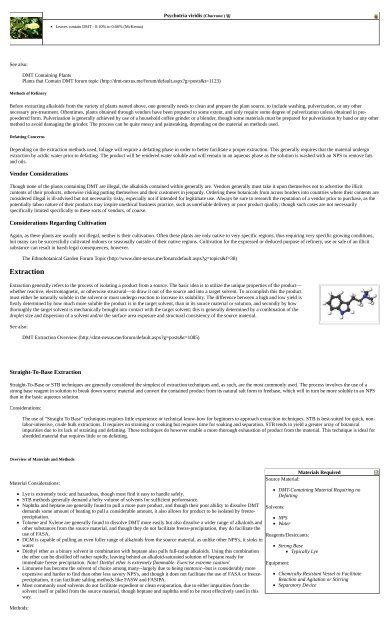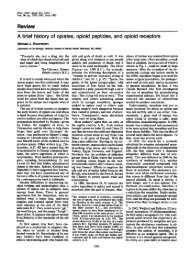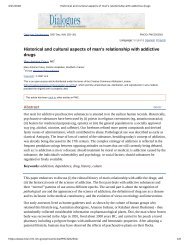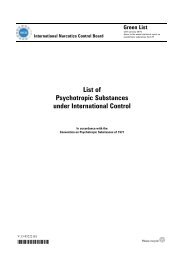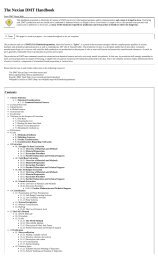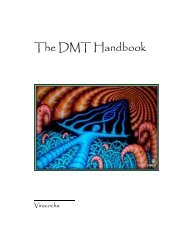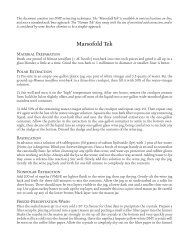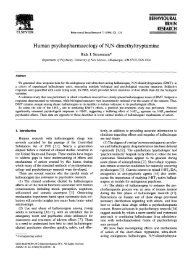The Nexian DMT Handbook - DMT-Nexus Wiki
The Nexian DMT Handbook - DMT-Nexus Wiki
The Nexian DMT Handbook - DMT-Nexus Wiki
Create successful ePaper yourself
Turn your PDF publications into a flip-book with our unique Google optimized e-Paper software.
Psychotria viridis (Chacruna )<br />
Leaves contain <strong>DMT</strong> - 0.10% to 0.66% (McKenna)<br />
See also:<br />
<strong>DMT</strong> Containing Plants<br />
Plants that Contain <strong>DMT</strong> forum topic (http://dmt-nexus.me/forum/default.aspx?g=posts&t=1123)<br />
Methods of Refinery<br />
Before extracting alkaloids from the variety of plants named above, one generally needs to clean and prepare the plant source, to include washing, pulverization, or any other<br />
necessary pre-treatment. Oftentimes, plants obtained through vendors have been prepared to some extent, and only require some degree of pulverization unless obtained in prepowdered<br />
form. Pulverization is generally achieved by use of a household coffee grinder or a blender, though some materials must be prepared for pulverization by hand or any other<br />
method to avoid damaging the grinder. <strong>The</strong> process can be quite messy and painstaking, depending on the material an methods used.<br />
Defatting Concerns<br />
Depending on the extraction methods used, foliage will require a defatting phase in order to better facilitate a proper extraction. This generally requires that the material undergo<br />
extraction by acidic water prior to defatting. <strong>The</strong> product will be rendered water soluble and will remain in an aqueous phase as the solution is washed with an NPS to remove fats<br />
and oils.<br />
Vendor Considerations<br />
Though none of the plants containing <strong>DMT</strong> are illegal, the alkaloids contained within generally are. Vendors generally must take it upon themselves not to advertise the illicit<br />
contents of their products, otherwise risking putting themselves and their customers in jeopardy. Ordering these botanicals from across borders into countries where their contents are<br />
considered illegal is ill-advised but not necessarily risky, especially not if intended for legitimate use. Always be sure to research the reputation of a vendor prior to purchase, as the<br />
potentially taboo nature of their products may inspire unethical business practice, such as unreliable delivery or poor product quality; though such cases are not necessarily<br />
specifically limited specifically to these sorts of vendors, of course.<br />
Considerations Regarding Cultivation<br />
Again, as these plants are usually not illegal, neither is their cultivation. Often these plants are only native to very specific regions, thus requiring very specific growing conditions,<br />
but many can be successfully cultivated indoors or seasonally outside of their native regions. Cultivation for the expressed or deduced purpose of refinery, use or sale of an illicit<br />
substance can result in harsh legal consequences, however.<br />
<strong>The</strong> Ethnobotanical Garden Forum Topic (http://www.dmt-nexus.me/forum/default.aspx?g=topics&f=38)<br />
Extraction<br />
Extraction generally refers to the process of isolating a product from a source. <strong>The</strong> basic idea is to utilize the unique properties of the product—<br />
whether reactive, electromagnetic, or otherwise structural—to draw it out of the source and into a target solvent. To accomplish this the product<br />
must either be naturally soluble in the solvent or must undergo reaction to increase its solubility. <strong>The</strong> difference between a high and low yield is<br />
firstly determined by how much more soluble the product is in the target solvent, than in its source material or solution, and secondly by how<br />
thoroughly the target solvent is mechanically brought into contact with the target solvent; this is generally determined by a combination of the<br />
droplet size and dispersion of a solvent and/or the surface area exposure and structural consistency of the source material.<br />
See also:<br />
<strong>DMT</strong> Extraction Overview (http://dmt-nexus.me/forum/default.aspx?g=posts&t=1085)<br />
Straight-To-Base Extraction<br />
Straight-To-Base or STB techniques are generally considered the simplest of extraction techniques and, as such, are the most commonly used. <strong>The</strong> process involves the use of a<br />
strong base reagent in solution to break down source material and convert the contained product from its natural salt form to freebase, which will in turn be more soluble in an NPS<br />
than in the basic aqueous solution.<br />
Considerations:<br />
<strong>The</strong> use of "Straight To Base" techniques requires little experience or technical know-how for beginners to approach extraction techniques. STB is best-suited for quick, nonlabor-intensive,<br />
crude bulk extractions. It requires no straining or cooking but requires time for soaking and separation. STB tends to yield a greater array of botanical<br />
impurities due to its lack of straining and defatting. <strong>The</strong>se techniques do however enable a more thorough exhaustion of product from the material. This technique is ideal for<br />
shredded material that requires little or no defatting.<br />
Overview of Materials and Methods<br />
Material Considerations:<br />
Methods:<br />
Lye is extremely toxic and hazardous, though most find it easy to handle safely.<br />
STB methods generally demand a hefty volume of solvents for sufficient performance.<br />
Naphtha and heptane are generally found to pull a more pure product, and though their poor ability to dissolve <strong>DMT</strong><br />
demands some amount of heating to pull a considerable amount, it also allows for product to be isolated by freezeprecipitation.<br />
Toluene and Xylene are generally found to dissolve <strong>DMT</strong> more easily but also dissolve a wider range of alkaloids and<br />
other substances from the source material, and though they do not facilitate freeze-precipitation, they do facilitate the<br />
use of FASA.<br />
DCM is capable of pulling an even fuller range of alkaloids from the source material, as unlike other NPS's, it sinks in<br />
water.<br />
Diethyl ether as a binary solvent in combination with heptane also pulls full-range alkaloids. Using this combination<br />
the ether can be distilled off rather rapidly, leaving behind an alkaloid-saturated solution of heptane ready for<br />
immediate freeze precipitation. Note! Diethyl ether is extremely flammable. Exercise extreme caution!<br />
Limonene has become the solvent of choice among many--largely due to being nontoxic--but is considerably more<br />
expensive and harder to find than other less savory NPS's, and though it does not facilitate the use of FASA or freezeprecipitation,<br />
it can facilitate salting methods like FASW and FASIPA.<br />
Most commonly used solvents do not facilitate expedient or clean evaporation, due to either impurities from the<br />
solvent itself or pulled from the source material, though heptane and naphtha tend to be most effectively used in this<br />
way.<br />
Materials Required<br />
Source Material:<br />
Solvents:<br />
<strong>DMT</strong>-Containing Material Requiring no<br />
Defatting<br />
NPS<br />
Water<br />
Reagents/Desiccants:<br />
Equipment:<br />
Strong Base<br />
Typically Lye<br />
Chemically Resistant Vessel to Facilitate<br />
Reaction and Agitation or Stirring<br />
Separatory Device


